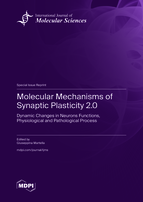Molecular Mechanisms of Synaptic Plasticity 2.0: Dynamic Changes in Neurons Functions, Physiological and Pathological Process
A special issue of International Journal of Molecular Sciences (ISSN 1422-0067). This special issue belongs to the section "Molecular Neurobiology".
Deadline for manuscript submissions: closed (30 November 2020) | Viewed by 36969
Special Issue Editor
Interests: pathophysiology; movement disorders; motor memory; motor dysfunction; synaptic plasticity; brain circuitry; basal ganglia; striatum (putamen); medium spiny neurons; mitochondria; neurologic and phychiatric disorders; protein synthesis
Special Issues, Collections and Topics in MDPI journals
Special Issue Information
Dear Colleagues,
This Special Issue is a continuation of our previous Special Issue “Molecular Mechanisms of Synaptic Plasticity: Dynamic Changes in Neurons Functions”. (https://0-www-mdpi-com.brum.beds.ac.uk/journal/ijms/special_issues/mechanisms_synaptic_plasticity)
Synaptic plasticity is a complex and crucial neuronal mechanism linked to principal memory and motor functions. During the developmental period into old age, the neural frame is subject to structural and functional modifications in response to external stimuli. This essential skill of neuronal cells underpins the ability to learn of mammalian organisms (Glanzman et al., 2010).
Synaptic plasticity phenomena include microscopic changes such as spine pruning and macroscopic changes such as cortical remapping in response to injury (Citri and Malenka 2008; Hofer et al., 2009). The increase of neurological and neuropsychiatric disorders in the current century—although this increase did not occur among the aging population—has resulted in an improved urgency to understand the aberrant processes connected to these diseases (Martella et al., 2016; 2018; Bonsi et al 2018).
In the last decades, it has been highlighted that de novo protein synthesis, (mRNA transcription mRNA and protein degradation, histone acetylation, DNA methylation, and miRNA regulation), as well as a new set of signaling molecules (endogenously generated cannabinoids, peptides, Neurotrophins, protein kinases, and ubiquitin-proteasome system), has been implicated in synaptic transmission and plasticity (McAllister et al ., 1999; Wilson & Nicoll 2001; Barki-Harrington et al., 2009; Belelovsky et al., 2009; Gal-Ben-Ari et al., 2012; Giese and Mizuno, 2013; Graff and Tsai, 2013; Jarome and Helmstetter, 2013; Saab and Mansuy, 2014).
The aim of this Special Issue is to collect original papers, reviews, case reports, and other forms of scientific communication that could increase the interest of scientists in synaptic plasticity phenomena.
Dr. Giuseppina Martella
Guest Editor
Manuscript Submission Information
Manuscripts should be submitted online at www.mdpi.com by registering and logging in to this website. Once you are registered, click here to go to the submission form. Manuscripts can be submitted until the deadline. All submissions that pass pre-check are peer-reviewed. Accepted papers will be published continuously in the journal (as soon as accepted) and will be listed together on the special issue website. Research articles, review articles as well as short communications are invited. For planned papers, a title and short abstract (about 100 words) can be sent to the Editorial Office for announcement on this website.
Submitted manuscripts should not have been published previously, nor be under consideration for publication elsewhere (except conference proceedings papers). All manuscripts are thoroughly refereed through a single-blind peer-review process. A guide for authors and other relevant information for submission of manuscripts is available on the Instructions for Authors page. International Journal of Molecular Sciences is an international peer-reviewed open access semimonthly journal published by MDPI.
Please visit the Instructions for Authors page before submitting a manuscript. There is an Article Processing Charge (APC) for publication in this open access journal. For details about the APC please see here. Submitted papers should be well formatted and use good English. Authors may use MDPI's English editing service prior to publication or during author revisions.
Keywords
- synaptic plasticity
- synaptic mechanism
- synaptic response
- neural network
- neurological and neuropsychiatric disorders
- molecular pathway
- neuronal circuitry
- dynamic changes in synapses
- neuron function re-arraignments
- motor and memory learning







